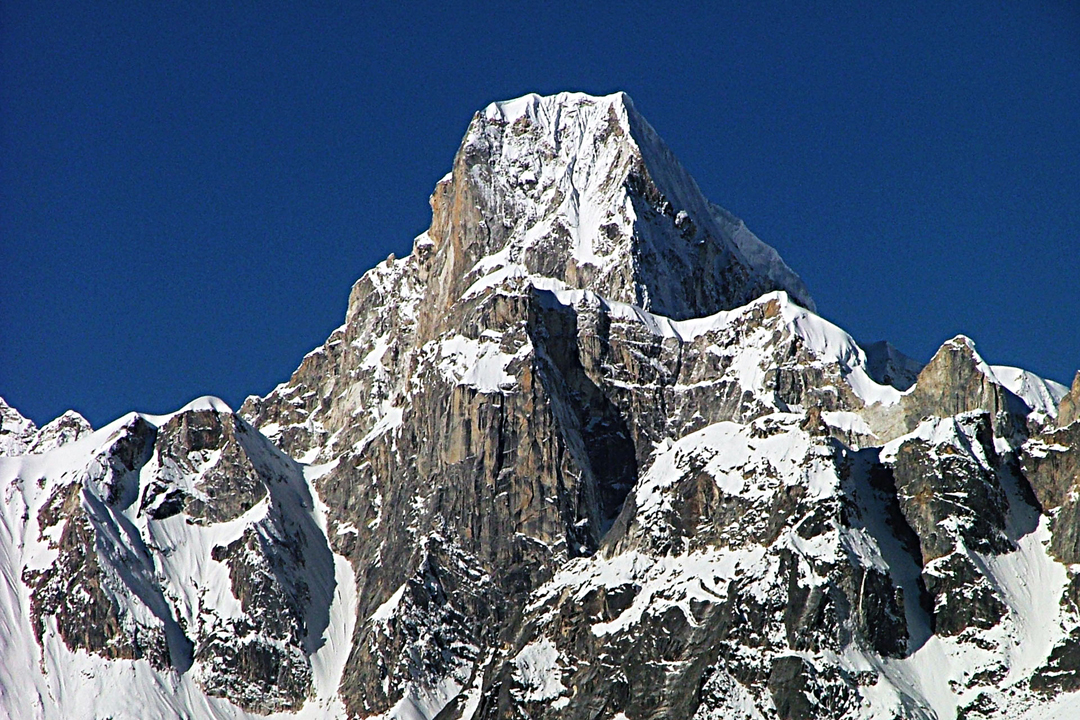Larkya Peak (Larkya Main), First Ascent by Southeast Face
Nepal, Manaslu Himal
 Larkya Peak (6,416m) lies on the ridge north of Manaslu North and is visible from the northeast along the classic Manaslu Circuit trek. From the south, many climbers ascending Manaslu’s normal route have a clear view of Larkya Peak’s impressive granite southeast face. However, the approach to the southeast face is long and difficult.
Larkya Peak (6,416m) lies on the ridge north of Manaslu North and is visible from the northeast along the classic Manaslu Circuit trek. From the south, many climbers ascending Manaslu’s normal route have a clear view of Larkya Peak’s impressive granite southeast face. However, the approach to the southeast face is long and difficult.
Thanks to the support from the Georgian Federation and the Ministry for Sport and Youth, we were privileged to climb outside the Caucasus. Georgians were pioneers of Soviet mountaineering but only within the Iron Curtain; until 2017 a Georgian team had not made a first ascent in the Himalaya. Larkya Peak—unclimbed, remote, difficult, and in an area of unstable weather—seemed the right challenge for us.
Bakar Gelashvili, Giorgi Tepnadze, Gia Tortladze, and I approached via Besisahar and the western part of the Manaslu Circuit. We crossed over Larkya La, continued east to Dharamsala, and from then headed southwest up the Syacha Glacier to a base camp at 4,550m, which we reached on September 16. Next day we established advanced base at 4,700m after a few hours of walking on difficult moraine. We then ascended post-glacial slopes to around 5,000m (satellite images show ice here only a few years ago), then 200m of ice. There was a certain amount of objective danger on this stretch, and Gia decided to head home. Our high camp below the wall was at 5,600m.
The safest and most logical line on the face was directly up the center, left of a giant rock scar and close to what we had envisaged when studying photos at home. The wall was snow-free, despite storms, forcing us to carry an extra 10 liters of water to 6,000m.
We began climbing on September 22. The weather was bad, and by the time we had climbed three pitches over loose rock up to M4, we were soaked. We fixed three ropes and descended. Next day we hauled up all our gear, including the portaledge, and added one more, quality mixed pitch. On the 24th we climbed a further four pitches to 6,050m, hauled up all the gear, and spent the night.
The crux headwall rose from 6,070m to around 6,400m. On the 25th, Giorgi took the lead. Fortunately, it got warmer for a few hours as he aided through loose rock (up to A3+), climbed a 6a crack system in rock shoes, and then aided a 40m A4 pitch that took him a full five hours.
After a second night at the same portaledge camp, we took off for the summit with just a small bivouac tent. I led that day through three overhanging sections. We bivouacked at 6,200m, and the next day, the 27th, climbed very difficult terrain to reach the final snow slope. By headlamp we continued to the summit, on which we were all standing at 8 p.m., being loudly happy and toasting ourselves with a drop of whiskey. Our GPS recorded 6,425m.
We rappelled through the night to regain our portaledge at 6,050m, had a lazy day there, and then continued our descent through the next night to the foot of the wall. With 1,700m of ascent from advanced base, of which 700m were on the southeast face (17 pitches), our Georgian Route was rated ED1 6a M5 A4 80°.
– Archil Badriashvili, Georgia






